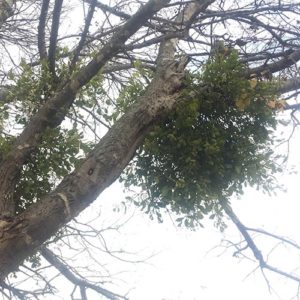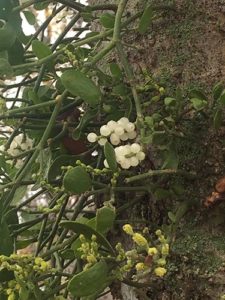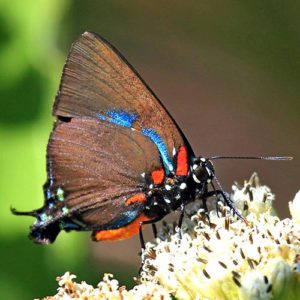It’s hard to miss the basketball-sized clusters of green leaves decorating the bare upper branches of trees as they reach up to the winter sky. Those basketball-sized clusters of leaves are most often mistletoes. There are several different species of mistletoe in North America, and even more in other parts of the world. Some prefer conifers. Others prefer deciduous hardwoods. Probably the most common species that prefers hardwoods in the eastern half of the U.S. is the American mistletoe, also known as the oak mistletoe (Phoradendron leucarpum). This is the species I’m most familiar with and that decorates the trees on our farm and in the surrounding region.

General Biology and Life History
American mistletoe is an evergreen, hemi-parasitic, woody shrub. Hemi-parasitic just means that it is partially parasitic. Photosynthesis and the production of sugars that the plant uses for food occurs in American mistletoe’s evergreen leaves in the same way that the process occurs in the leaves of most non-parasitic plants. However, unlike most non-parasitic plants, American mistletoe does not draw its water and mineral requirements from the soil. Instead, it gets its water and minerals from the tree on which it is growing. Thus, the parasitic part of its nature.
Although another one of its common names is oak mistletoe, American mistletoe doesn’t just grow on oaks. It can be found growing on the branches of many different types of hardwood trees including oaks, maples, ashes, walnuts, and many more. American mistletoe typically blooms in the fall and early winter, or approximately October through December in Kentucky. Mistletoe has male and female plants which means that some plants only have female flowers and some plants only have male flowers.
Fertilized female flowers will produce a white berry with a very sticky seed and pulp. Birds eating the berry will often swipe their beaks along a branch to try to wipe the stickiness off their bills. In the process of wiping their bills, they’ll often wipe the mistletoe seed into a crack in the bark. The seeds may also stick to the bird’s feathers or feet and be moved in that manner from one tree to the next. Not to mention, what goes in, must come out and mistletoe seeds that are eaten by birds tend to come out relatively quickly, often being deposited on a different branch or in a different tree from the original plant.
When a mistletoe seed lands on a tree branch, it germinates and sends out shoots that penetrate the tree’s bark. Those shoots produce a chemical that tricks the tree into thinking that the mistletoe is a tree branch. The tree sends water and minerals to the mistletoe just like it would any other branch. Some sources say that mistletoes can also cause the tree to send extra water and minerals to it, even at the expense of the rest of the tree. Whether that is true of all mistletoes or only certain species is unclear.
Pollinator and Wildlife Uses

Many different types of insects, including wasps, bees, and ants, frequently visit American mistletoe flowers. Bees of all types, including honey bees and native bees, will collect nectar and pollen from mistletoe flowers. The ripe berries are quickly eaten by a wide variety of birds in the late fall and winter. American mistletoe is also the only thing that the caterpillar of the great purple hairstreak butterfly (Atlides halesus) will eat. In addition to the variety of food sources mistletoe provides, its dense, shrubby growth pattern also provides cover and protection for nesting birds and treetop dwelling mammals.
Human Uses of Mistletoe
Different species of mistletoes have been used over the centuries for religious purposes and for medicinal purposes. However, mistletoes are also poisonous to humans with some species being more poisonous than others. Most sources say that American mistletoe is less poisonous than its European cousin, but why chance it? Just, don’t eat the mistletoe. Any mistletoe.
The use for mistletoe that most of us are probably more familiar with is as a holiday decoration to inspire kissing. The kissing custom is thought to date back possibly to the 16th century in Europe and was brought over to North America relatively early in the colonial days. The American mistletoe is one of at least three species which is sometimes called the Christmas mistletoe because of its use for holiday decorations.
Incorporating American Mistletoe into Your Yard
American mistletoe isn’t a plant that you are going to “plant” in your yard. It is either going to show up on its own, or it isn’t. Some resources say that trees serving as hosts for mistletoes have a significantly shortened lifespan. Others say that any damage mistletoes do is dependent on a number of factors, such as, the health of the tree and how much mistletoe it is supporting. The species of mistletoe also seems to be one of the determining factors for whether its presence significantly shortens the tree’s life.

Some of the mistletoe species that prefer conifers have been scientifically shown to shorten the tree’s life. Although that may sound like a bad thing, it is a natural part of the ecosystem and creates habitat for a wide variety of animals. On the other hand, scientific evidence is much less clear as to whether American mistletoe, which prefers hardwoods, shortens its host tree’s life. Maybe if there was a lot of American mistletoe in a tree, then it might have a negative effect on the tree, but usually a few clumps on a healthy tree don’t seem to do much.
We have quite a few clumps of mistletoes growing in the trees on our property. I like looking out and seeing them, especially in the winter when the rest of the tree is bare. I also know that they provide important resources for my birds and pollinators, so I don’t worry about them. The trees with mistletoe growing on them look the same as neighboring mistletoe-free trees, so I assume everything is good. Plus, the American mistletoe shrubs are WAY up in the tops of the trees where it would be hard to do anything about them anyway.
If you are concerned about a clump of mistletoe in your trees, then you will need to find where the main trunk of the mistletoe enters the tree branch. Then cut the branch at least a foot back towards the tree trunk from where the mistletoe trunk enters the tree branch. However, there is no way to stop birds from depositing new mistletoe seeds on your tree branches. My advice is to just let it be unless there is a pressing need to do otherwise.
Summary
American mistletoe is an interesting, native plant with a fascinating life history. It is a valuable part of our ecosystem and provides shelter for nesting birds and tree dwelling mammals. In addition, it is a valuable food source for many of our pollinators, songbirds, and the caterpillar of the great purple hairstreak. American mistletoe also plays a role in our holiday traditions. Although it isn’t a species that we might plant in our yards, it is still a fun one to enjoy when it shows up.

Backyard Ecology: Exploring Nature in Your Backyard
Nature isn’t just “out there.” It’s all around us, including right outside our doors. Hi, my name is Shannon Trimboli, and I am the host of Backyard Ecology. I live in southcentral Kentucky and am a wildlife biologist, educator, author, beekeeper, and owner of a nursery specializing in plants for pollinators and wildlife conservation. I invite you to join me as we ignite our curiosity and natural wonder, explore our yards and communities, and improve our local pollinator and wildlife habitat. Learn more or subscribe to my email list at www.backyardecology.net.

Leave a Reply